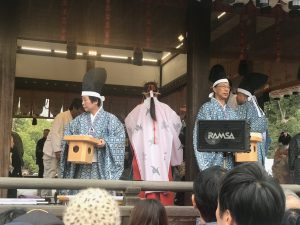February 3 is a fairly important day in Japan. All across the country Setsubun is celebrated, and it’s one of the odder rituals on the Shinto calendar. It marks the day before the beginning of Spring (on the old lunar calendar). Basically it’s a cleansing ritual to rid the house (or shrine or temple) of evil spirits and start fresh with a new year. This is accomplished through Mamemaki – bean scattering – ritual which actually started in China. “Oni wa soto! Fuku wa uchi!” – “Demons out, luck in!”.
Because I’m me, I decided to celebrate Setsubun in Kyoto this year, as I’ve never done that before. There are several well-known Setsubun celebrations in Kyoto (Yoshida Jinja is probably the most popular, with over 600 food stalls). I chose to check out two of the other popular options, Yasaka Shrine and Heian Jingu. These provided very different experiences.
At Yasaka the distinctive feature of the event is that the fuku mame (lucky beans) which are tossed into the crowd are thrown by geisha. Geisha also perform on the shrine’s kagura stage. It’s not uncommon to see women dressed as geisha around Gion, but it’s relatively rare to see actual geisha (they’re discreet) – about 98% are tourists who pay for the privilege of cosplaying geisha. And since geisha performances are normally very expensive, the chance to see them for free was too good to pass up.
Heian Jingu’s event was much more traditional, complete with costumed oni terrorizing small children to tears (in some parts of Japan, especially up north, the oni really try to inflict serious trauma on Setsubun), onmyouji, and sacred arrow shooting. This fellow in fact shot what sure looked like a real arrow over the crowd, and it stuck in the ground about 10 feet from me (no barriers of any kind kept onlookers away from the landing spot, either). There’s also a demon-fighter called Housoushi leading a group of children around the grounds, chanting, and oni storming the shrine and being repelled by beans tossed by priests.
The pinnacle of the event comes with the mamemaki, when the fuku mame are tossed to the crowd. I’ve been through a few of these and it can get pretty boisterous, but the one at Heian Jingu was especially intense. As the massive crowd pushed towards the stage the taiko pounded, and an increasingly heavy rain began pelting down. The rain and the drumming seemed to work the crowd of parents, salarymen and seniors into a frenzy and I won’t lie, it was pretty rough in the middle of it.
The duck, by the way, was captured at Toji, where I stopped by for the monthly antiques market. His name shall heretofore be Ahiru no Ou-sama.


























Ronbb
February 10, 2019 at 2:03 am“February 3 is a fairly important day…it’s a cleansing ritual to rid the house…which actually started in China.”
Thanks Enzo for sharing this, and wishing you great health, happiness and success in the Year of the Pig!
I’m fascinated by history and culture, and how one culture influences another. It’s true that February 3 was a day — for at least the Chinese — of deep cleaning before welcoming the Year of the Pig. February 4 — the day before the Lunar New Year — was the day to visit the market and buy some flowers to decorate your house. Well, at least this was what I was told by our grandparents.
What a steel to see a live geisha performance. 😉 The event at the Heian Jingu is very interesting. Judging from the costume, it looks like it’s telling a story in the Heian period.
I’m visualizing the mamemaki in my head as you described, and I hope that no one got hurt. Also, does that mean that luck and fortune will come to you when you get one of those fuku mame? Are you supposed to open the bag and finish the beans inside or just keep the whole bag for the year?
Guardian Enzo
February 10, 2019 at 8:41 amI wondered about that too, but I think you’re supposed to eat the beans.
Heian Jingu is basically a scale reproduction of the Heian imperial palace, so yeah, the whole ritual was taken from that era’s version of it.
Ronbb
February 10, 2019 at 11:09 amThanks! I have never been to Heian Jingu — now I have more places to experience if I get the chance to visit Kyoto. 🙂